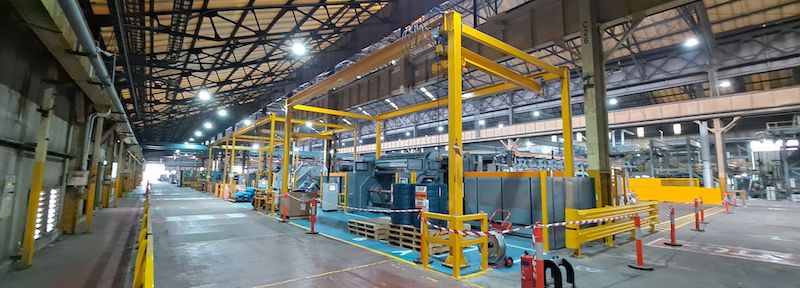Have you considered how the right bridge crane design could transform your operations? A well-engineered lifting system does more than move heavy loads—it enhances efficiency, improves safety, and ensures seamless reliability. The right design can streamline workflow, reduce downtime, and minimise operational risks in warehouses, manufacturing plants, and construction sites. Whether upgrading an existing system or investing in a new one, careful planning is key to achieving long-term performance.
What is a Bridge Crane?
In industrial settings, lifting systems are essential for handling heavy materials with precision and safety. A bridge crane consists of several key components, including a bridge, trolley, hoist, and support structures. Each element ensures smooth operation, durability, and compliance with industry standards. When designed correctly, these systems improve workflow efficiency and reduce the risk of workplace accidents.
What Are the Things to Consider When Choosing One?
Selecting the right lifting system isn’t just about capacity, efficiency, durability, and safety. A well-designed system should align with your operational needs, ensuring smooth material handling and long-term reliability. Here are the key factors to keep in mind when making your choice.
Bridge Structure
The bridge is the system’s backbone, supporting the weight and movement of loads across the workspace. Single-girder designs are ideal for lighter loads and cost-effective setups, while double-girder systems offer greater strength for heavier applications. Choosing the proper structure ensures efficiency without compromising durability or safety.
Trolley and Hoist System
The trolley moves along the bridge, carrying the hoist for lifting and lowering materials. Wire rope hoists are best for heavy-duty applications, while chain hoists work well for lighter loads and frequent use. A well-matched trolley and hoist setup ensures smooth, controlled, and reliable movement.
End Trucks and Runway System
End trucks support the bridge and allow the system to move seamlessly along the runway. Proper alignment of the runway system prevents excessive wear and tear, reducing maintenance costs over time. A well-built structure ensures stability and improves the overall lifespan of the lifting system.
Electrical and Control System
Modern cranes have advanced electrical and control technologies that enhance safety and precision. Features like variable frequency drives (VFDs), remote controls, and automation help operators handle materials more accurately. An intelligent control system makes operation easier while reducing risks associated with manual handling.
Considering these factors, you can invest in a lifting system that meets your current needs and supports long-term efficiency and safety in your operations.
What Are the Key Factors of a Bridge Crane Design?
Designing a bridge crane isn’t just about lifting heavy loads—it’s about ensuring efficiency, safety, and long-term performance. A well-planned system reduces downtime, improves workflow, and prevents costly maintenance issues. Here are the essential factors to consider when designing a reliable and effective system.
Load Capacity and Duty Cycle
Every lifting system must be built to handle the expected weight safely and efficiently. The duty cycle—which measures how often and how intensively the system will be used—determines the components needed for durability. Choosing the proper specifications prevents premature wear, system failures, and unnecessary downtime.
Span and Lift Height
The span (width of the system) and lift height (how high materials need to be lifted) play a crucial role in performance. A well-calculated design ensures smooth operation within the available space while maximising load-handling capacity. Customising these factors to your workspace prevents operational bottlenecks and improves overall efficiency.
Operational Environment
A lifting system’s durability depends on its environment. Factors like temperature, humidity, dust, and chemical exposure can impact its materials and coatings. Choosing corrosion-resistant materials and protective finishes ensures the system remains reliable, even in the harshest working conditions.
Safety Features and Compliance
Safety is a top priority in lifting operations. Features like overload protection, emergency stop functions, limit switches, and automated monitoring help prevent accidents and equipment damage. Ensuring compliance with workplace safety regulations protects workers and helps avoid costly legal issues and downtime.
By considering these key factors, businesses can invest in a system that delivers long-term reliability, improved workflow, and a safer work environment.
Why Does Choosing Design for a Bridge Crane Matter?
The right lifting system design isn’t just about moving heavy loads—it is crucial for efficiency, safety, and long-term performance. A well-planned setup ensures seamless workflow, minimises downtime and enhances workplace safety. When each component is carefully planned to suit your operations, the risk of malfunctions, delays, and unnecessary maintenance costs is significantly reduced.
Beyond performance, a properly designed system helps extend equipment lifespan and optimise productivity. Investing in the proper structure from the beginning prevents operational bottlenecks, reduces wear and tear, and improves precision in material handling. With a setup built to support your business, you ensure efficiency, safety, and adaptability for future growth.
Why Choose Global Track Australia?
At Global Track Australia, we know that no two businesses have the exact material handling needs. We specialise in custom bridge crane designs that match your requirements. With a focus on safety, efficiency, and innovation, we deliver lifting solutions that enhance productivity and reduce risks.
Ready to build a better system? Contact us today to create a lifting solution that works for your business!


